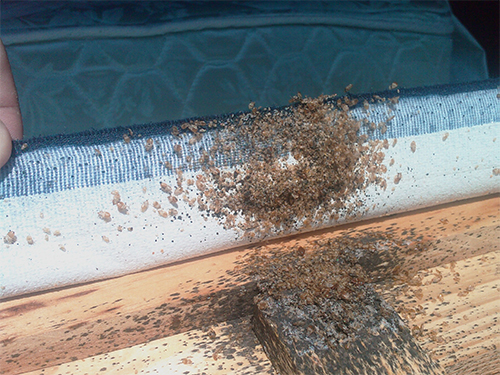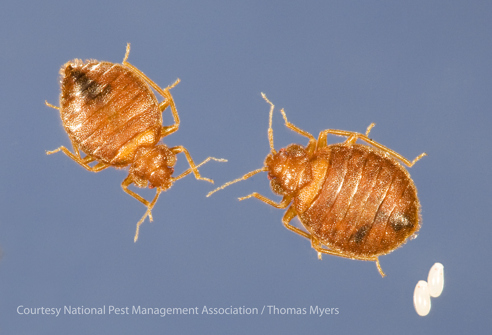How to Recognize Bed Bug Bites and Treat Them Quickly
How to Recognize Bed Bug Bites and Treat Them Quickly
Blog Article
Get Enlightened About the Kinds Of Pest Control Approaches and Their Advantages for Property Owners
Recognizing the different bug control methods available to property owners is vital for efficient bug monitoring. From chemical and biological methods to mechanical and cultural methods, each approach provides one-of-a-kind benefits that can dramatically impact both health and wellness and ecological security. Home owners that are knowledgeable can make strategic choices that not only address parasite concerns yet likewise improve the overall high quality of their living setting. As we check out these methods even more, it ends up being clear that the decision-making process entails greater than just instant results; it touches on long-lasting sustainability and well-being. What factors should influence these essential choices?
Chemical Pest Control Techniques
Chemical bug control methods are a critical component of incorporated pest management methods for homeowners seeking efficient remedies to pest problems. These approaches entail the application of chemical materials designed to eliminate or discourage bugs that threaten personal building, health and wellness, and convenience. Usual chemicals used include pesticides, herbicides, rodenticides, and fungicides, each tailored to target details pests.
The primary advantage of chemical parasite control is its quick effectiveness; several solutions supply prompt outcomes, decreasing pest populaces considerably quickly. In addition, breakthroughs in chemical formulas have led to items that are more eco friendly and have lower poisoning degrees for non-target organisms when applied appropriately.

Organic Bug Control Methods
Natural pest control approaches have obtained prominence as home owners seek more secure and a lot more lasting options to standard chemical methods. Organic insect control methods utilize natural killers, bloodsuckers, or virus to take care of bug populations properly. This approach is not just eco-friendly yet also decreases the danger of harm to non-target species, including helpful insects and wild animals.
One of one of the most typical organic control approaches entails presenting natural killers right into the environment. As an example, ladybugs can be used to manage aphid populaces, while nematodes target soil-dwelling bugs like grubs. In addition, parasitoids-- organisms that reside on or within a host-- can be utilized to regulate particular pest species by laying eggs inside them, inevitably bring about their demise.
One more approach is making use of biopesticides, which are acquired from natural materials such as germs, minerals, or plants (bed bug exterminator). These items can properly target parasites while posturing minimal threat to animals and humans. In general, organic parasite control strategies offer home owners with a reliable means of pest monitoring that lines up with environmental concepts, advertising a much healthier living atmosphere while minimizing dependence on artificial chemicals
Mechanical Insect Control Methods
Mechanical bug control approaches include a selection of techniques that literally avoid or remove pests without using chemicals. These methods are specifically helpful for homeowners seeking ecologically pleasant options while ensuring the security of their home.
One common method is using obstacles, such as displays, webs, and traps, which stop parasites from entering homes or certain locations. As an example, setting up home window displays can successfully keep pests out, while using physical barriers around gardens can deter larger insects like rabbits or deer. Furthermore, mechanical traps created for rodents can record and eliminate these parasites without the demand for hazardous substances.
Another effective method involves using mops and vacuum cleaners to get rid of bugs directly from surfaces. Regular cleansing and upkeep can substantially reduce bug populations by eliminating food resources and hiding spots. Furthermore, using gadgets like ultrasonic insect repellents can deter different pests with noise waves that are undesirable to them yet faint to people.
Social Insect Control Practices
Social insect control techniques focus on customizing the atmosphere and management techniques to develop conditions that are less favorable to pest problems. These methods are essential in description keeping a well balanced environment and reducing the dependence on chemical interventions. By changing farming practices, homeowners can effectively prevent insects while promoting plant wellness.
One common technique consists of crop rotation, which disrupts the life process of bugs by transforming the kinds of plants expanded in a certain area (bed bug exterminator). This not only minimizes pest populaces yet likewise improves soil health and wellness. Additionally, intercropping-- planting varied crops in closeness-- can puzzle bugs and reduce their capability to situate their recommended host plants
Water administration is an additional vital facet of social methods. Appropriate irrigation strategies can protect against standing water, which serves as a reproduction ground for insects and other insects. Maintaining cleanliness in and around the home, such as frequently getting rid of particles and food waste, can considerably reduce insect destination.
Incorporating these cultural methods right into a thorough pest management strategy allows homeowners to develop a setting that normally prevents bugs, thus boosting the efficiency of various other control methods while advertising sustainable horticulture and landscape design.

Integrated Pest Monitoring Approaches
Integrated Bug Monitoring (IPM) represents a holistic method that combines numerous strategies to efficiently manage insect populaces while lessening ecological effect. This methodology integrates biological, social, physical, and chemical practices to achieve lasting insect control. By evaluating pest populations and their natural enemies, IPM stresses tracking and recognizing parasites before applying control measures.
One of the core principles of IPM is making use of limits, which establish the degree of insect activity that calls for treatment. This ensures that treatments are applied only when required, lowering the reliance on chemical pesticides. Organic control approaches, such as like this introducing all-natural killers or bloodsuckers, operate in combination with cultural methods like plant rotation and habitat manipulation to disrupt pest life cycles.
Furthermore, IPM urges using least-toxic chemical alternatives when intervention is needed, focusing on items that present minimal danger to non-target microorganisms and the atmosphere. For house owners, adopting IPM approaches not just improves the efficiency of pest administration but also advertises a much healthier living environment, fostering biodiversity and minimizing chemical exposure. Inevitably, IPM encourages home owners to make informed choices that balance parasite control with ecological obligation.
Conclusion
Finally, understanding the numerous pest control techniques empowers homeowners to make educated choices pertaining to pest monitoring. Each technique-- chemical, biological, mechanical, social, and incorporated parasite administration-- provides distinctive benefits that deal with different needs and choices. By selecting suitable techniques, home owners can effectively manage pest populations while reducing health threats and ecological impacts. This educated approach adds to a healthier living atmosphere, promoting general wellness for family members and animals alike.
Recognizing the numerous parasite control methods available to house owners my website is important for efficient bug management.Chemical bug control techniques are an essential part of integrated parasite administration methods for house owners looking for effective solutions to pest infestations. Generally, organic pest control techniques provide property owners with an efficient means of parasite monitoring that straightens with eco-friendly principles, promoting a healthier living setting while decreasing reliance on artificial chemicals.
Social pest control techniques focus on modifying the atmosphere and monitoring methods to create problems that are less favorable to pest infestations.In conclusion, recognizing the different bug control approaches encourages home owners to make informed choices concerning pest administration.
Report this page